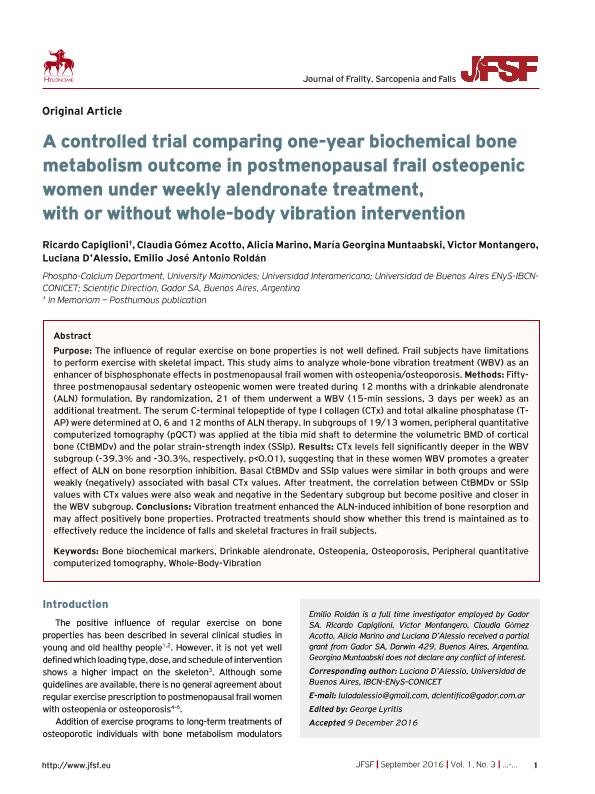Artículo
A controlled trial comparing one-year biochemical bone metabolism outcome in postmenopausal frail osteopenic women under weekly alendronate treatment, with or without whole-body vibration intervention
Capiglioni, Ricardo; Gómez Acotto, Claudia; Marino, Alicia; Muntaabski, María Georgina; Montangero, Victor; D`Alessio, Luciana ; Roldán, Emilio José Antonio
; Roldán, Emilio José Antonio
 ; Roldán, Emilio José Antonio
; Roldán, Emilio José Antonio
Fecha de publicación:
09/2016
Editorial:
Hylonome Editions
Revista:
Journal of Frailty, Sarcopenia and Falls
ISSN:
2459-4148
Idioma:
Inglés
Tipo de recurso:
Artículo publicado
Clasificación temática:
Resumen
Purpose: The influence of regular exercise on bone properties is not well defined. Frail subjects have limitations to perform exercise with skeletal impact. This study aims to analyze whole-bone vibration treatment (WBV) as an enhancer of bisphosphonate effects in postmenopausal frail women with osteopenia/osteoporosis. Methods: Fiftythree postmenopausal sedentary osteopenic women were treated during 12 months with a drinkable alendronate (ALN) formulation. By randomization, 21 of them underwent a WBV (15-min sessions, 3 days per week) as an additional treatment. The serum C-terminal telopeptide of type I collagen (CTx) and total alkaline phosphatase (TAP) were determined at 0, 6 and 12 months of ALN therapy. In subgroups of 19/13 women, peripheral quantitative computerized tomography (pQCT) was applied at the tibia mid shaft to determine the volumetric BMD of cortical bone (CtBMDv) and the polar strain-strength index (SSIp). Results: CTx levels fell significantly deeper in the WBV subgroup (-39.3% and -30.3%, respectively, p<0.01), suggesting that in these women WBV promotes a greater effect of ALN on bone resorption inhibition. Basal CtBMDv and SSIp values were similar in both groups and were weakly (negatively) associated with basal CTx values. After treatment, the correlation between CtBMDv or SSIp values with CTx values were also weak and negative in the Sedentary subgroup but become positive and closer in the WBV subgroup. Conclusions: Vibration treatment enhanced the ALN-induced inhibition of bone resorption and may affect positively bone properties. Protracted treatments should show whether this trend is maintained as to effectively reduce the incidence of falls and skeletal fractures in frail subjects.
Archivos asociados
Licencia
Identificadores
Colecciones
Articulos(IBCN)
Articulos de INST.DE BIOLO.CEL.Y NEURCS."PROF.E.DE ROBERTIS"
Articulos de INST.DE BIOLO.CEL.Y NEURCS."PROF.E.DE ROBERTIS"
Citación
Capiglioni, Ricardo; Gómez Acotto, Claudia; Marino, Alicia; Muntaabski, María Georgina; Montangero, Victor; et al.; A controlled trial comparing one-year biochemical bone metabolism outcome in postmenopausal frail osteopenic women under weekly alendronate treatment, with or without whole-body vibration intervention; Hylonome Editions; Journal of Frailty, Sarcopenia and Falls; 1; 3; 9-2016; 29-
Compartir



